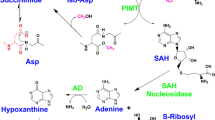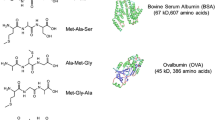Abstract
Purpose
The loss of potency of protein therapeutics can be linked to the oxidation of specific amino acid residues leading to a great variety of oxidative modifications. The comprehensive identification of these oxidative modifications requires high-resolution mass spectrometry analysis, which requires time and expensive resources. Here, we propose a fluorogenic derivatization method of oxidized Tyr and Phe yielding benzoxazole derivatives, as an orthogonal technique for the rapid screening of protein oxidation.
Methods
Four model proteins, IgG1, human growth hormone (hGH), insulin and bovine serum albumin (BSA) were exposed to oxidation via peroxyl radicals and metal-catalyzed reactions and efficiently screened by fluorogenic derivatization of Tyr and Phe oxidation products. Complementary LC-MS analysis was done to identify the extent of methionine oxidation in oxidized proteins.
Results
The Fluorogenic derivatization technique can easily be adapted to a 96-well plate, in which several protein formulations can be screened in short time. Representatively for hGH, we show that the formation of benzoxazole parallels the oxidation of Met to methionine sulfoxide which enables estimation of Met oxidation by just recording the fluorescence.
Conclusions
Our rapid fluorescence based screening allows for the fast comparison of the stability of multiple formulations.
















Similar content being viewed by others
Abbreviations
- AAPH:
-
2, 2′-azobis (2-methylpropionamidine) dihydrochloride
- ABS:
-
4-(aminomethyl) benzenesulfonic acid
- BMS:
-
bis (2-mercaptoethyl) sulfone
- BSA:
-
Bovine serum albumin
- DOCH:
-
2-amino-3-(3, 4-dioxocyclohexa-1, 5-dien-1-yl) propanoic acid
- DOPA:
-
3, 4-dihydroxyphenylalanine
- hGH:
-
Human growth hormone
- IAA:
-
Iodoacetamide
- IgG:
-
Immunoglobulin G
- LTQ-FT:
-
Linear ion trap quadrupole-Fourier transform
- MCO:
-
Metal catalyzed oxidation
- Q-TOF:
-
Quadrupole time-of-flight
- SEC:
-
Size exclusion chromatography
References
Benjamin L, Quentin JB, Golan DE. Protein therapeutics: a summary and pharmacological classification. Nat Rev Drug Discov. 2008;7:21–39.
Li S, Schöneich C, Borchardt RT. Chemical instability of protein pharmaceuticals. Mechanisms of oxidation and strategies for stabilization. Biotechnol Bioeng. 1995;48:490–500.
Manning CM, Chou DK, Murphy MB, Payne WR, Katayama SD. Stability of protein pharmaceuticals: an update. Pharm Res. 2010;27(4):544–75.
Hawe A, Wiggenhorn M, Van De Weert M, Garbe HJ, Mahler HC, Jiskoot W. Forced degradation of therapeutic proteins. J Pharm Sci. 2011;101(3):895–913.
Wang W. Instability, stabilization, and formulation of liquid protein pharmaceuticals. Int J Pharm. 1999;185:129–88.
Schöneich C, Hageman JM, Borchardt TB. Stability of peptides and proteins. In K. Park (Ed.) Controlled Drug Delivery. Am Chem Soc 1997;205–28.
Zhong X, Neumann P, Corbo M, Loh E. Recent advances in biotherapeutics drug discovery and development. Kapetanovic M I (Ed) Drug Discovery and Development-Present and Future. INTECH 2011 (www.intechopen.com).
Torosantucci R, Schöneich C, Jiskoot W. Oxidation of therapeutic proteins and peptides: structural and biological consequences. Pharm Res. 2014;31:541–53.
Wang W, Vlasak J, Li Y, Pristatsky P, Fang Y, Pittman T, Roman J, Wang Y, Prueksaritanont T, Ionescu R. Impact of methionine oxidation in human IgG1 Fc on serum half-life of monoclonal antibodies. Mol Immunology. 2011;48:860–6.
Gaza-Bulesco G, Faldu S, Hurkmans K, Chumsae C, Liu H. Effect of methionine oxidation of a recombinant monoclonal antibody on the binding affinity to protein a and protein G. J Chromatogr B. 2008;870:55–62.
Wei Z, Feng J, Lin HY, Mullapudi S, Bishop E, et al. Identification of a single tryptophan residue as critical for binding activity in a humanized monoclonal antibody against respiratory syntical virus. Anal Chem. 2007;79:2797–805.
Kerwin B. Polysorbates 20 and 80 used in the formulation of protein biotherapeutics: structure and degradation pathways. J Pharm Sci. 2008;97:2924–35.
Donbrow M, Azaz E, Pillersdorf A. Autoxidation of polysorbates. J Pharm Sci. 1978;67:1676–81.
Zhou S, Mozziconacci O, Kerwin AB, Schöneich C. Fluorogenic tagging methodology applied to characterize oxidized tyrosine and phenylalanine in an immunoglobulin monoclonal antibody. Pharm Res. 2013;30:1311–27.
Stadtman ER, Olivier CN. Metal-catalyzed oxidation of proteins. J Biol Chem. 1991;266(4):2005–8.
Stadtman ER. Oxidation of free amino acid residues in proteins by radiolysis and metal- catalyzed reactions. Annu Rev Biochem. 1993;62:797–821.
Mozziconacci O, Ji JA, Wang J, Schöneich C. Metal-catalyzed oxidation of protein methionine residues in human parathyroid hormone (1-34): formation of homocysteine and a novel methionine-dependent hydrolysis reaction. Mol Pharm. 2012;10:739–55.
Chen G, Pramanik NB. Application of LC/MS to proteomics studies: current status and future prospects. Drug Discov Today. 2009;14:465–71.
Chen G, Warrack MB, Goodenough KA, Wei H, Wang-inverson BD, Tymiak AA. Characterization of protein therapeutics by mass spectrometry: recent developments and future developments. Drug Discov Today. 2011;16:58–64.
Schöneich C, Sharov VS. Mass spectrometry of protein modifications by reactive oxygen and nitrogen species. Free Radic Biol Med. 2006;41:1507–20.
Kaltashov IA, Bobst CE, Abzalimov RR, Wang G, Baykal B, Wang S. Advances and challenges in analytical characterization of biotechnology products: mass spectrometry-based approaches to study properties and behavior of protein therapeutics. Biotechnol Adv. 2012;30:210–22.
Sharov VS, Dremina ES, Galeva NA, Gerstenecker GS, Li X, Dobrowsky RT, Stobaugh JF, Schöneich C. Fluorogenic tagging of peptide and protein 3-Nitrotyrosine with 4-(amino methyl)-benzenesulfonicacid for quantitative analysis of protein tyrosine nitration. Chromatographia. 2010;71:37–53.
Sharov VS, Dremina ES, Pennington J, Killmer J, Asmus C, Thorson M, Hong SJ, Li X, Stobaugh JF, Schöneich C. Selective fluorogenic derivatization of 3-nitrotyrosine and 3,4-dihydroxyphenylalanine in peptides: a method designed for quantitative proteomic analysis. Methods Enzymol. 2008;441:19–32.
Kishore RS, Kiese S, Fischer S, Pappenberger A, Grauschopf U, Mahler H-C. The degradation of polysorbates 20 and 80 and its potential impact on the stability of biotherapeutics. Pharm Res. 2011;28(5):1194–210.
Betigeri S, Thakur A, Raghavan K. Use of 2-2′- Azobis (2- Amidinopropane) Dihydrochloride as a reagent tool for evaluation of oxidative stability of drugs. Pharm Res. 2005;22:310–7.
Werber J, Wang JY, Milligan M, Li M, Ji AJ. Analysis of 2-2′- Azobis (2- Amidinopropane) Dihydrochloride degradation and hydrolysis in aqueous solution. J Pharm Sci. 2011;100(8):3307–15.
Ji J, Zhang B, Cheng W, Wang JY. Methionine, tryptophan, and Histidine Oxidation in a Model protein, PTH: Mechanisms and stabilization. J Pharm Sci. 2009;98:4485–500.
Steinmann D, Ji JA, Wang YJ, Schöneich C. Oxidation of human growth hormone by oxygen-centered radicals: formation of Leu-101 hydroperoxides and Tyr-103 oxidation products. Mol Pharm. 2012;9:803–14.
Zhao F, Ghezzo-Schöneich E, Aced GI, Hong J, Milby T, Schöneich C. Metal-catalyzed oxidation of histidine in human growth hormone. Mechanism, isotope effects, and inhibition by a mild denaturing alcohol. J Biol Chem. 1997;272:9019–29.
Shevchenko A, Tomas H, Havli J, Olsen JV, Mann M. In-gel digestion for mass spectrometric characterization of proteins and proteomes. Nat Protoc. 2007;1:2856–60.
Xu H, Freitas MA. MassMatrix: a database search program for rapid characterization of proteins and peptides from tandem spectroscopy data. Proteomics. 2009;9:1548–55.
Mani RD, Abbatiello ES, Carr AS. Statistical characterization of multiple-reaction monitoring mass spectrometry (MRM-MS) assays for quantitative proteomics. BioMed Central. 2012;13:S9.
Seema B, Ajit T, Raghavan K. Use of 2,2′- Azobis(2-Amidinopropane) Dihydrochloride as a reagent tool for evaluation of oxidative stability of drugs. Pharm Res. 2005;22:310–317.
Hawkins CL, Davies MJ. Generation and propagation of radical reactions on proteins. Biochim Biophys Acta. 2001;1504:196–219.
Berges J, Trouillas P, Houee-Levin C. Oxidation of protein tyrosine or methionine residues: from the amino acid to peptide. J Phys Conf Ser. 2011;261
White RE. High-throughput screening in drug metabolism and pharmacokinetic support of drug discovery. Annu Rev Pharmacol Toxicol. 2000;40:133–57.
Capelle M, Gurny R, Arvinte T. High throughput screening of protein formulation stability: practical considerations. Eur J Pharm Biopharm. 2007;65:131–48.
Niki E. Free radical initiators as source of water-or lipid-soluble peroxyl radicals. Methods Enzymol. 1990;186:100–8.
Schöneich C. Methionine oxidation by reactive oxygen species: reaction mechanisms and relevance to Alzheimer’s disease. Biochim Biophys Acta. 2005;1703(2):111–9.
Author information
Authors and Affiliations
Corresponding author
Electronic supplementary material
ESM 1
(DOCX 682 kb)
Rights and permissions
About this article
Cite this article
Bommana, R., Mozziconacci, O., John Wang, Y. et al. An Efficient and Rapid Method to Monitor the Oxidative Degradation of Protein Pharmaceuticals: Probing Tyrosine Oxidation with Fluorogenic Derivatization. Pharm Res 34, 1428–1443 (2017). https://doi.org/10.1007/s11095-017-2159-6
Received:
Accepted:
Published:
Issue Date:
DOI: https://doi.org/10.1007/s11095-017-2159-6




